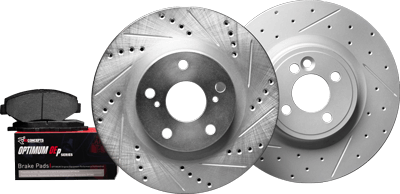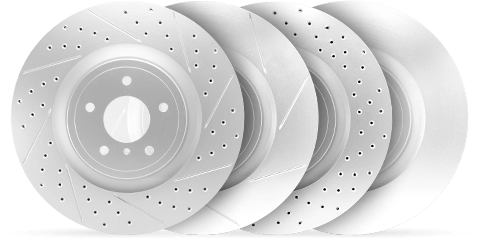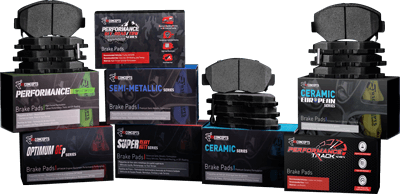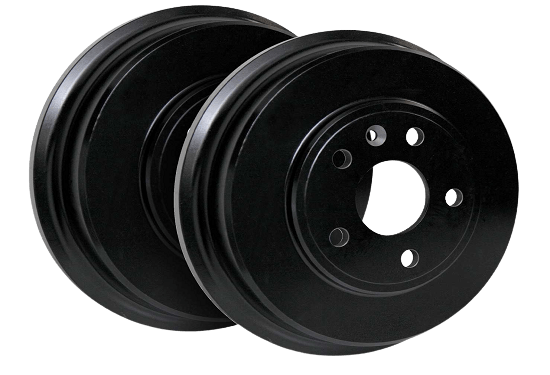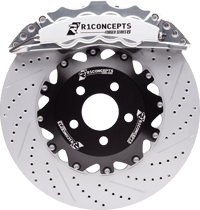Choosing the right brake rotor type for your Ford Escape can significantly affect your vehicle’s performance and safety. This quick guide will explain the main rotor types available—solid, slotted, drilled, and drilled & slotted rotors—and help you determine which is best suited for your driving needs. In addition, we will discuss the specific “rotor types for Ford Escape” to ensure you make the best choice for your vehicle.
Key Takeaways
Ford Escape owners can choose from four main types of brake rotors: solid, slotted, drilled, and drilled & slotted, each offering unique benefits for different driving conditions and styles.
Selecting the right brake rotor depends on driving habits, environmental conditions, and the balance between cost and performance, ensuring optimal braking efficiency and longevity.
Proper installation and regular maintenance of brake rotors, whether DIY or professional, are crucial for the safety and performance of the Ford Escape’s braking system.
Choosing the Right Rotor Type for Your Ford Escape

Choosing the perfect brake rotor is like picking the right pair of shoes; it’s not just about the fit, but also about where you’ll use them and how you’ll use them. For your Ford Escape, this choice can greatly impact how well your brakes work and how long they last. You need to think about your car’s details, how you drive, and the environment you drive in.
Many factors, including your Escape’s make and model and the type of terrain you frequently drive on, influence this decision. So, it’s not just about what you like; it’s about finding the best match for your driving style and needs.
Driving Style Considerations
Your driving style tells a lot about which brake rotor is best for you. If you drive gently, with smooth stops and steady speeds, then regular blank rotors are good for you. They are simple and do their job well without costing too much.
But if you drive fast, often speeding up and slowing down quickly, you need stronger rotors. These high-performance rotors can handle the extra heat and pressure from aggressive driving. They are great for driving in heavy traffic or on twisty roads.
High-performance rotors have several advantages for those who drive hard:
They can handle more heat and stress, so they keep working well for a long time.
They give you confidence to drive with energy and excitement.
They help your brakes last longer.
Choosing high-performance rotors is a smart choice if you want a better driving experience and to take care of your car.
Environmental Factors
The world outside your Ford Escape’s window can have a big impact on which brake rotors you should choose. If you live in a place with a lot of rain or humidity, rust can be a problem, and your brakes might not work as well. In these conditions, you need rotors that can resist rust and keep your brakes working safely. If you often drive in the mountains, you need rotors that can handle the heat from going up and down hills.
Choosing the right rotors for your environment is important. If you live near the coast or in places where they use a lot of road salt, coated rotors can protect against rust. On the other hand, if you live in a dry, flat area, you have more options and might not need these special features. Knowing what kind of roads and weather you usually drive in helps you pick the best rotors for your Ford Escape, so your brakes stay strong and reliable no matter what.
Cost vs. Performance
Although the cost-versus-performance debate is hardly new, it deserves careful contemplation when selecting brake rotors for your Ford Escape. While it’s tempting to opt for the most economical option, the true cost of a rotor goes beyond the price tag. It’s about weighing the initial investment against the longevity and performance benefits that come with higher quality options. As the saying goes, “You get what you pay for,” and in the realm of brake rotors, this couldn’t be truer.
Opting for premium aftermarket rotors may come with a higher upfront cost, but the reduction in the frequency of replacements and the enhanced braking performance they offer can make them a more cost-effective choice in the long run. Conversely, cheaper OEM rotors might initially seem like a bargain, but if they require more frequent servicing or replacement, they can end up being more costly over time. Thus, when selecting rotors for your Ford Escape, it’s important to look beyond the sticker price and consider the long-term implications of your choice, ensuring a balanced approach to both cost and performance.
Popular Brands and Products
Among the multitude of brake rotor options, the R1 eLINE Series distinguishes itself as a symbol of reliability and performance. These rotors are designed to deliver maximum stopping power and durability, making them a popular choice among Ford Escape owners who prioritize both safety and longevity. Whether you’re replacing worn parts or upgrading your vehicle’s braking system, the eLINE Series offers a solution that embodies the quality and confidence you seek in a rotor.
Installation Tips and Maintenance
Correct installation and regular maintenance underpin the peak performance of brake rotors. Equipping yourself with the right tools, such as a reliable torque wrench, and adhering to the specified torque values—100 ft/lbs for the front caliper bracket bolt, and 70 ft/lbs for the rear—is essential for ensuring a secure and precise fit.
Additionally, taking the time to replace caliper pin boots and clean their corresponding holes during installation can prevent future issues, including caliper binding, further safeguarding the integrity and functionality of your Ford Escape’s braking system.
DIY vs. Professional Installation
Many Ford Escape owners grapple with the decision of whether to install rotors themselves or hire a professional. For those with a knack for mechanics and access to the necessary tools, such as a 3/8” hex bit and a C-clamp, the DIY approach can be a cost-saving adventure. It’s a path that offers the satisfaction of hands-on involvement and the pride of personal accomplishment. However, the DIY route is not without its risks; a misstep or oversight can lead to complications, such as warped rotors, which can diminish braking performance and safety.
On the flip side, entrusting the installation to professionals can offer peace of mind. The expertise of a seasoned mechanic ensures that the job is done correctly, utilizing high-quality parts and avoiding common pitfalls. While the cost of professional installation might be higher, it’s an investment in the reliability and safety of your braking system. For those less familiar with the intricacies of automotive maintenance, or for whom time is a luxury, professional installation is a worthwhile consideration that protects both your Ford Escape and your wallet.
Maintenance Best Practices
The upkeep of your Ford Escape’s brake rotors is as critical as any other vehicle maintenance task. Regular inspections can reveal telltale signs of wear, such as grooves or warping, alerting you to the need for attention before issues escalate.
To maintain your brake rotors, follow these steps:
Keep rotors clean from dust and debris to enhance their performance and extend their service life.
Regularly inspect the rotors for any signs of wear or damage.
Clean and lubricate slide pins to prevent caliper issues and ensure smooth and effective brake operation.
By following these steps, you can ensure that each stop is as reliable as the last.
For those Ford Escapes equipped with an electronic rear parking brake, entering brake maintenance mode during servicing is a step that cannot be overlooked. This specialized procedure ensures that the electronic system is properly managed, protecting its components during maintenance tasks. By adhering to these best practices, you not only safeguard the performance of your brakes but also contribute to the overall safety of your driving experience.
Regular care and attention to detail are the keys to keeping your Ford Escape’s braking system in top condition, providing you with the confidence to tackle any road with ease.
Summary
Navigating the world of brake rotors for the Ford Escape can be daunting, but armed with the right information, it becomes a journey well worth embarking on. From understanding the various rotor types and their respective benefits to weighing the cost and performance, this guide has laid out the essential considerations for making an informed decision. Remember that the choice of rotors will influence not just the braking performance but also the overall safety of your vehicle. With the insights gained here, you’re now equipped to select, install, and maintain the ideal brake rotors for your Ford Escape, ensuring a driving experience that is both secure and enjoyable.
Frequently Asked Questions
Can I replace just one brake rotor on my Ford Escape, or do I need to replace them in pairs?
Yes, it’s recommended to replace brake rotors in pairs to maintain even braking performance and prevent safety issues.
How often should I check my Ford Escape’s brake rotors for wear?
You should check your Ford Escape’s brake rotors for wear during each tire rotation or at least twice a year to look for any signs of grooving or warping. Regular inspections are crucial for maintaining brake rotor health.
Are drilled and slotted rotors better than blank rotors for my Ford Escape?
The best choice between drilled and slotted rotors and blank rotors for your Ford Escape depends on your driving style and needs. Drilled and slotted rotors offer improved cooling and are suitable for high-performance driving, while blank rotors are durable and cost-effective for everyday driving.
Will high-quality aftermarket rotors last longer than OEM rotors for my Ford Escape?
Yes, high-quality aftermarket rotors can last longer than OEM rotors for your Ford Escape, potentially offering better long-term performance and cost savings.
Is it necessary to put my Ford Escape in brake maintenance mode when servicing the brakes?
Yes, it is necessary to put your Ford Escape in brake maintenance mode when servicing the brakes, especially if it’s equipped with an electronic rear parking brake, to protect the electronic components.


